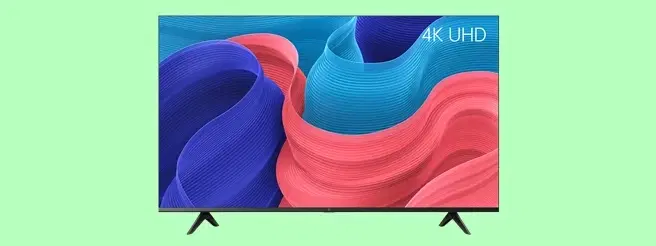
Consumer Electronics
•03 min read

Buy SAMSUNG S95F 195 cm (77 inch) OLED 4K Ultra HD Smart Tizen TV with Built-in Alexa (2025 model) online at best prices from Croma. Check product details, reviews & more. Shop now!
Imagine a world where your TV offers unparalleled brightness, vibrant colours, and longevity like never before. In today's tech-savvy era, display technologies have taken centre stage. This post delves into the nuances of OLED vs MicroLED, answering frequently asked questions and guiding you in understanding the key differences and advantages when choosing between these revolutionary screen technologies.
OLED, short for Organic Light Emitting Diode, uses organic compounds that produce self-emissive pixels. Each pixel can emit its own light, which means displays can achieve exceptional black levels, are extremely thin and offer wide viewing angles. These features make OLED screens a popular choice for televisions, monitors, smartphones, and wearable devices.
MicroLED is the next generation of display technology that utilises microscopic LEDs to produce superior brightness and enhanced durability. Thanks to its inorganic materials, MicroLED displays not only offer outstanding brightness and colour accuracy, but they also promise a longer lifespan. This technology is increasingly being explored for large-screen TVs, AR/VR devices, and even automotive displays.
OLED is renowned for its perfect black levels and an infinite contrast ratio, which is ideal for a cinematic viewing experience. In contrast, MicroLED builds on these features by delivering higher brightness and enhanced colour accuracy, making it particularly well-suited for well-lit environments.
OLED displays are known for their energy efficiency, but they may be vulnerable to burn-in over time. MicroLED, on the other hand, uses more robust inorganic materials that not only improve energy efficiency but also offer a significantly longer lifespan. This attribute adds to the appeal of MicroLED, especially for users with long-term usage in mind.
Currently, OLED has the edge in affordability, largely due to its established manufacturing processes. Meanwhile, MicroLED remains on the premium side with higher production expenses. However, as innovations continue and production scales up, we may see MicroLED prices become more accessible. The scalability of MicroLED also allows for the creation of large, modular displays, a key factor for commercial and industrial applications.
Thanks to its use of stronger, inorganic LEDs, MicroLED can achieve stellar brightness levels. This makes it an excellent option for rooms with plenty of ambient light or even outdoor settings. While its contrast is impressive, OLED still maintains an edge with its infinite black levels.
A commonly raised concern with OLED is the possibility of burn-in over extended use. MicroLED addresses this issue by using materials that are less susceptible to such degradation. The result is a display that not only lasts longer but also maintains consistent performance over time.
One of the exciting benefits of MicroLED is its modular nature. Displays can be scaled up to create large screens without any loss in quality, which is a significant advantage for commercial installations or expansive home theatres.
For those seeking a cinematic experience in the comfort of their living room, OLED TVs excel with their deep blacks and rich, vibrant colours. However, if you enjoy watching TV in bright spaces or require a large-scale screen, MicroLED TVs provide enhanced brightness and durability. Just remember, Express Delivery is available in selected locations and for orders placed before 6pm, so always check availability if you need your device quickly.
Gamers often prioritise faster response times and superior contrast to immerse themselves in the game. OLED meets these needs with its quick pixel response and excellent contrast. Conversely, MicroLED offers benefits for extended gaming sessions due to its higher brightness and reduced susceptibility to burn-in, ensuring a consistently sharp gaming display.
Insight Corner: Why Brightness Matters
Did you know? MicroLED displays can achieve brightness levels up to 10 times greater than OLED screens. This makes them a great option for environments with a lot of ambient light, ensuring that every detail is visible even in the brightest conditions.
MicroLED outperforms OLED in terms of brightness, durability, and lifespan, though OLED remains popular for its deep black levels and affordability.
The high cost and complex manufacturing process make MicroLED less accessible than OLED, although technological advancements may make it a more appealing option in the future.
OLED offers unmatched deep blacks and a cinematic viewing experience, while Mini LED can deliver better brightness performance at a lower price point.
Due to their intricate manufacturing processes and smaller production scale, MicroLEDs currently come with a higher price tag compared to OLED panels.
OLED is ideal for gaming enthusiasts because of its faster response times and superior contrast. Meanwhile, MicroLED is designed to perform exceptionally well in bright settings and during prolonged gaming sessions.
In summary, both OLED and MicroLED technologies are making significant strides in the world of display innovation. OLED is celebrated for its cinematic quality, affordability, and exceptional black levels, whereas MicroLED stands out with its superior brightness, durability, and scalability for larger screens. Your choice between these display technologies should be based on your specific needs—whether you value a deeper cinematic experience or require a screen that performs well in bright, dynamic environments. With a seamless shopping experience on Tata Neu and the added benefit of earning NeuCoins, making a smart and informed decision has never been easier. Enjoy the advancements in technology and the extra rewards as you explore these incredible display solutions.